How 11 Exercises Translate Into Daily Life

But if you want to be ready to tackle all the tasks you perform outside your workouts, it helps to perform exercises that resemble those same movements.
That’s why football linemen smash tackling dummies and prizefighters punch heavy bags: You get better at the things you practice. Trainers call this the “SAID” principle, or Specific Adaptation to Imposed Demands.
Not an elite athlete? Doesn’t matter. Everyone relies on strength, mobility, and muscle — so even if you climb stairs instead of mountains, chase toddlers instead of tennis balls, or lift grocery bags instead of Olympic bars, you can take advantage of the specificity principle.
Below are 11 exercises that mimic movements you do in everyday life. As it turns out, many of them are exceptional strength and fitness-builders as well — proving that being functional is being fit.
1. Squat
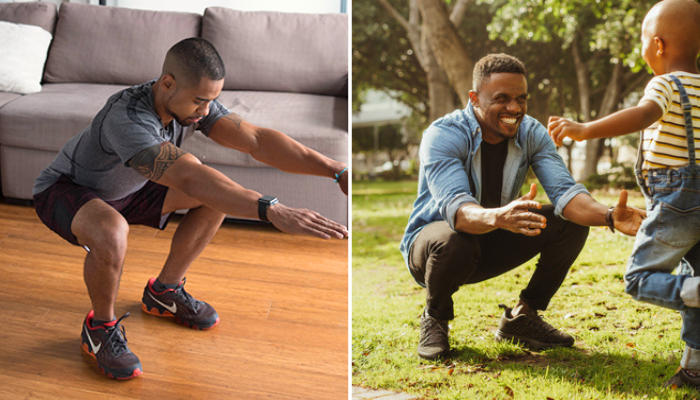
How squats make your day easier:
“It doesn’t get more foundational than the squat,” says David Otey, CSCS, author of Men’s Health 90 Day Transformation. “From gaining your first steps as a baby to picking your child up as a parent, squatting is a necessary and often-used pattern for our everyday lives.”
Doing squats regularly with good form (and extra resistance, if you can) helps make the sitting-to-standing transition easier. And that may inspire you to to get up out of your office chair more often to give your body and mind a much-needed break.
Squats may also help you leave the “get-up grunt” behind — that patented sound most people over a certain age make whenever they get up from a chair.
How to do it:
- Stand tall with your hands by your sides, feet shoulder-width apart, and toes pointed forward or slightly outward.
- Keeping your back flat and core braced, push your hips back, bend your knees, and lower your body until your thighs are parallel to the floor. You want to “sit” into the exercise, pushing your butt back like you’re lowering yourself onto a chair or bench.
- Pause, and then push yourself back up to the starting position.
Too easy? Perform the move with a barbell across your shoulders.
2. Deadlift
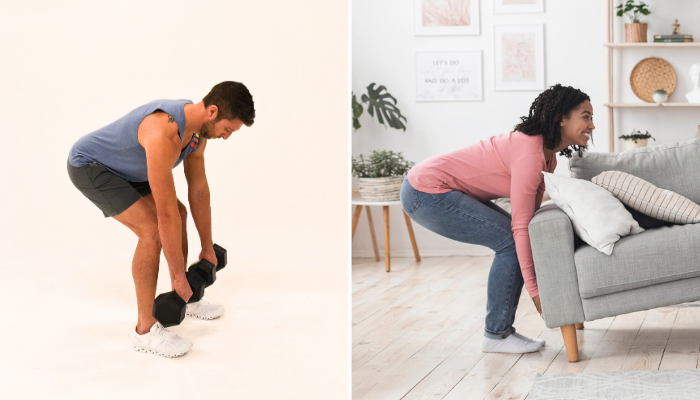
How deadlifts make your day easier:
In addition to building the entire back of your body — from your hamstrings to your glutes to your lats, traps, and lower back — deadlifts improve strength and mobility that you’ll use when you need to move furniture, perform heavy gardening activities, or even pick up toys after your kid’s epic playdate.
But deadlifting isn’t only about lifting, Otey says: “The deadlift is a key exercise to develop your hip hinging pattern, which is a pivotal movement for optimal hip health.”
How to do it:
- Stand behind a loaded barbell, a pair of heavy dumbbells, or a kettlebell.
- Bend your knees and hips and take an overhand grip on the weight.
- Keeping your back flat, your chest high, and your head in alignment with your spine, slowly stand, allowing the weight to hang directly down from your shoulders.
- Pause in the fully-upright position and reverse the movement, keeping your spine aligned the entire time.
3. Push-Up

How push-ups make your day easier:
Push-ups not only build your chest, arms, shoulders, and abs, but they also make it exponentially easier to get up from the floor — an everyday challenge most of us don’t execute very gracefully. (Just ask anyone who’s ever tried to fish an errant shoe from beneath the bed.)
Push-ups are a winner for your orthopedic health as well. “This move teaches you the shoulder is more than just the ball and socket joint at the top of your arm, but your entire upper region including your shoulder blades,” Otey says.
Learn to move your arm and shoulder blades in tandem, he adds, and your joints will thank you.
How to do it:
- Assume a high plank position on the floor with your wrists stacked underneath your shoulders, hands and balls of your feet on the floor, arms locked out, and body straight from your heels to the top of your head. (Keep your feet together for a more challenging push-up, or slightly apart for an easier push-up.)
- Keeping your body straight and your head in a neutral position, simultaneously bend your arms and retract your shoulder blades until your chest is about three inches from the floor (or as low as you can go without losing form).
- Reverse the movement, pushing yourself back up to the starting position.
Too hard? Perform the move with your hands on an elevated surface.
4. Bent-Over Row

How rows make your day easier:
Carrying anything — kids, groceries, luggage — becomes easier once you master the row. You’ll also build the grip strength you need to open a stubborn pickle-jar lid.
Need one more reason to row? “More people should spend time training their posterior chain to support our very front-sided lifestyles,” Otey says. Add this move to your workout routine, and you’ll improve your posture and help safeguard against shoulder injury.
How to do it:
- Holding a dumbbell in each hand, stand with your feet parallel and hip-width apart with a slight bend in your knees.
- Keeping your back flat and your core engaged, hinge at the hips and lean your chest forward until your torso is nearly parallel with the floor. Let your arms hang down with your palms facing each other.
- Keeping your elbows tucked and your core and glutes engaged, squeeze your shoulder blades together as you row the weights to your sides.
- Pause, then lower the weights to the starting position.
5. Farmer’s Walk
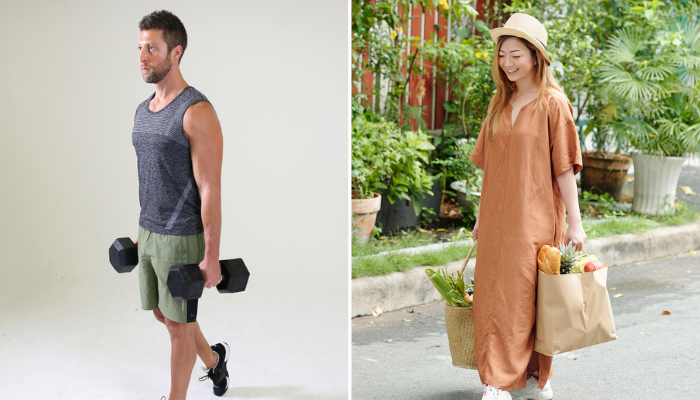
How farmer’s walks make your day easier:
“Loaded carries are the exercise that best translates to our everyday lives,” Otey says.
After all, hauling groceries and hauling dumbbells are about as similar as two movements can be. And if you’re a frequent traveler, you know the pain of lugging a heavy carry-on from one terminal to another while running to catch a connecting flight.
Farmer’s walks make all of this easier, challenging your grip, core, and postural muscles in the process.
How to do it:
- Grab a pair of heavy dumbbells or kettlebells, and hold them by your sides.
- Stand upright with your feet parallel and shoulder width apart, and your knees unlocked.
- Draw your shoulder blades back slightly, and pull your head back as if making a double chin. Hold this position throughout the movement.
- Looking straight ahead, walk forward for up to 60 seconds. Avoid swaying from side to side as you walk.
- Turn, and walk back.
- For a different kind of challenge, try the offset farmer’s carry (holding just one weight), the waiter’s walk (holding the weight overhead), or the logger’s walk (holding the weight at shoulder height).
6. Step-Up

How step-ups make your day easier:
One of the most challenging lower-body tasks we face in everyday life is the simple act of climbing stairs — hence escalators and elevators.
This seemingly simple movement actually requires hip mobility, balance, and coordination, along with strength and stability in the ankles, thighs, hamstrings, and glutes. Miss out on any of these crucial elements, and you risk falling.
Step-ups build strength in your legs and glutes while also helping you safely ascend actual stairs.
How to do it:
- Stand behind a bench, step, or high box.
- Place your whole left foot on the bench or box.
- Keeping your chest up and shoulders back, push your body up with your left leg until it’s straight (keep your right foot elevated).
- Pause, and then lower your body back to the starting position under control.
- Complete all reps with your left leg, then perform the same number of reps with your right leg on the bench.
Too easy? Hold a pair of dumbbells at your side to make the movement more challenging.
7. Overhead Press
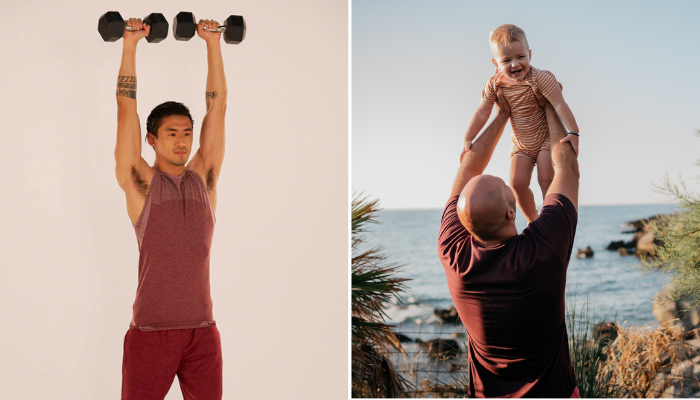
How overhead presses make your day easier:
Your shoulders are your most mobile joint, capable of rotating 360 degrees and reaching in front of, across, or behind you with ease.
But mobility is a “use-it-or-lose-it” proposition, so it’s important to practice moving your shoulders freely, and with maximal range, on a regular basis.
The overhead press helps you maintain the ability to reach overhead easily — an underappreciated skill that can help whether you’re grabbing a coffee mug off a high shelf or playing a game of pickup basketball.
In combination with the row and the push-up, full-range overhead presses also help you maintain all-around shoulder mobility, so that everyday moves like putting on your coat and reaching into the back seat of your car become easier.
How to do it:
- Stand upright holding a pair of dumbbells at shoulder height, palms facing each other.
- Keeping your torso upright, core tight, and elbows in, press the dumbbells overhead until your arms are straight and biceps are next to your ears, allowing your wrists to rotate naturally throughout the movement.
- Pause, then lower slowly to the starting position.
8. Seated Figure-4 Hip Stretch
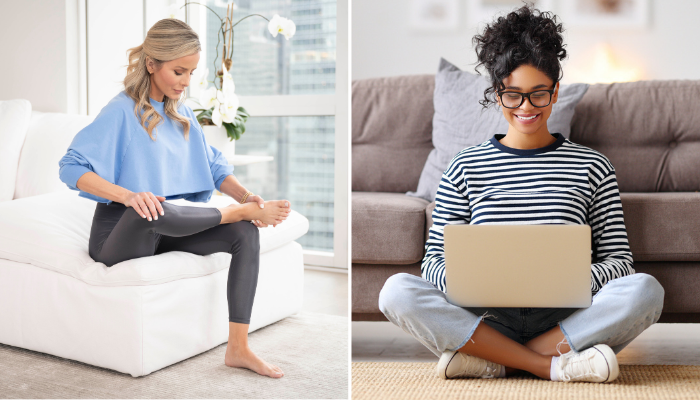
How figure-4 hip stretches make your day easier:
You know those people who can sit on the floor comfortably? They play with their kids, hang out with their dog, watch TV, or work on their laptops, all without a chair in sight.
Their secret? Healthy hips. When your hips can flex and bend and rotate freely, it’s far easier to get comfortable on the floor — and, indeed, to sit up comfortably on any surface.
Need more reasons to work figure-4 hip stretches into your daily routine? Research suggests improved hip mobility may help to alleviate lower back pain.
How to do it:
- Sit on a chair with your back straight and your feet flat on the floor.
- Raise your right foot from the floor and place your right ankle on your left knee.
- Keeping your back straight and your right ankle flexed, gently press down on your right knee with your right hand until you feel a deep stretch in your right hip and glute.
- Hold the stretch for 30 to 90 seconds, then repeat the move on the opposite side.
9. Bear Crawl
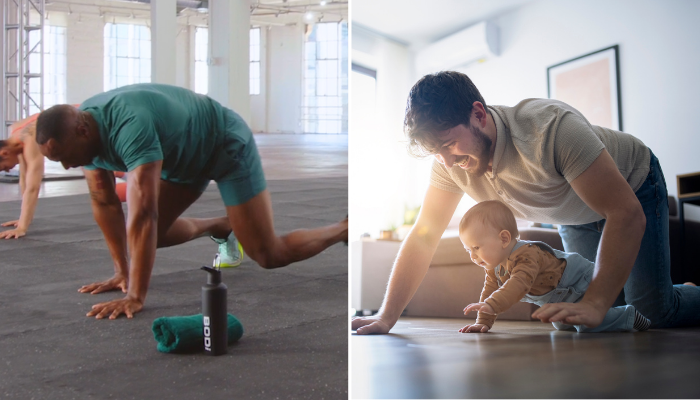
How bear crawls make your life easier:
The bear crawl reinforces “cross patterning” movement, which is when your right hand moves with your left leg, and vice versa. This an essential component of all forms of locomotion, from walking to full-out sprinting.
If you suffer from back pain or discomfort in your hip or knee when you walk or run, relearning this foundational movement — ingrained in most babies by the time they’re a few months old — can help you move with greater ease and comfort.
It’s also an effective and functional core-builder that works all 360 degrees of your spine-stabilizing muscles.
How to do it:
- Get on all fours with your hands directly below your shoulders and your knees directly below your hips.
- Keeping your spine parallel to the floor, lift your knees off the floor about three inches.
- Simultaneously walk your right hand and your left foot forward about six inches.
- Perform the same move with your left hand and your right foot.
- Use a “cross crawl” pattern to continue crawling forward, keeping your hips down and knees raised off the floor.
Too hard? Perform the move with your knees on the floor.
10. Split Jump
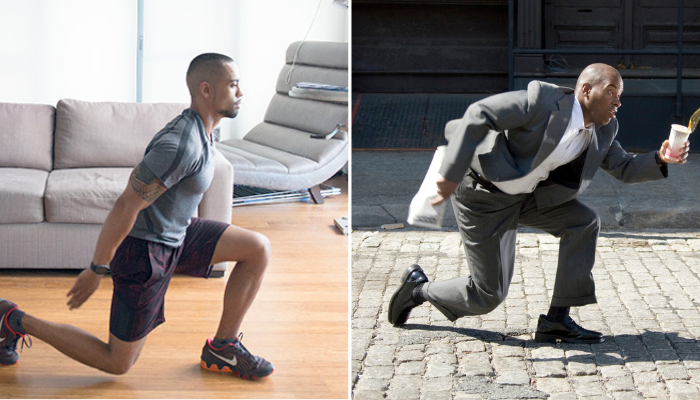
How split jumps make your life easier:
Most people think of “power” as synonymous with “strength,” but it’s not. Strength is the ability to lift something; power is the ability to lift it fast.
If you think you don’t need speed in everyday life, consider how quickly you have to move to prevent yourself from falling completely when you slip or stumble. If you’re an athlete, power training will help you perform your best on the field. If you’re not, it can be the ounce of prevention against the unpredictable in life.
Split jumps are one of the most effective power-builders you can do. You start and end in an athletic stance and improve your ability to accelerate off the ground and, on landing, your ability to decelerate smoothly and softly. A few sets a week, and you’ll be more prepared for whatever life throws at you.
How to do it:
- Stand with feet shoulder-width apart, then step your right foot directly forward about two feet.
- Bend both knees slightly and come up onto the ball of your left foot. Your right knee should be tracking right above your right ankle.
- Swing your arms back and flex both knees.
- Drive your arms forcefully forward and up and launch yourself upward as high as possible, switching the position of your legs in midair.
- Land as softly as possible with your left foot forward.
- Repeat, jumping continuously and switching your legs in midair on each rep.
11. Plank

How planks make your life easier:
The plank may not look like any of your usual daily tasks, but it’s still a terrifically functional move. Perform it often enough, and you’ll learn to brace your entire core, protecting your spine from excessive twisting, folding, and bending while you go about your daily activities.
The plank is also an effective posture-builder, helping you find your proper alignment and sit up straight with ease.
How to do it:
- Start in a push-up position, but lower yourself onto your forearms instead of your hands, with your elbows directly below your shoulders and palms flat.
- Engage your core and glutes to keep your body straight from head to heels.
- Hold the position for time.
Too easy? Walk your elbows forward of your shoulders, round your back towards the ceiling, and and squeeze your glutes as hard as you can.

Active movement of any kind will help you improve your fitness — whether you’re practicing yoga, sculling down a local river, or lifting the heaviest weights you can find.